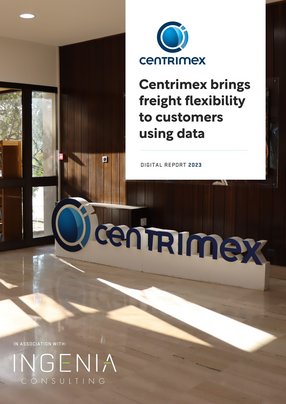Centrimex brings freight flexibility to customers using data
It’s safe to say that, if supply chain firms were leveraging the capabilities they have today, the process of change would be made that much simpler. In fact, it would allow businesses to positively thrive among adverse circumstances and come out stronger, faster.
Planning contingencies is no easy task, and one that’s often required at short notice—yet it’s where the use of real-time data really shines. The ability to track shipments and foresee disruption is a luxury that’s used at Centrimex, a freight-forwarding organisation that is committed to great service through dedication to even better visibility.
The company’s vision is to provide high quality services adapted to the customers’ needs, at the right price, and with a seamless experience to the customer. But, in an environment where disruption is rife, Alexia Schmitt, Chief Transformation and Information Officer at Centrimex, has a critical role to play. This particular role is responsible for getting goods from point A to point B by maintaining visibility—visibility that is driven by real-time data.
The aim of the business is to manage clients’ freight, from the shipping process to all of the documentation and processes required to ensure that goods are able to cross borders.
“The core mission is to manage services around the whole transportation process, with the best level of service for the customers,” says Schmitt. “This means bringing the expertise on geographical areas to customers, as well as the specific requirements for documentation or declarations that requires know-how and experience to meet specific and legal obligations.”
As the company continues to grow and offer exceptional freight-forwarding services, this starts with customer focus—ensuring that clients receive the best possible service throughout the shipping process and maintain confidence in the business.
“The first step is to understand the customer’s expectations. This is something that the company has been working on over the last two years through customer surveys and interviews with a sample of customers,” says Schmitt. “More than a hundred customers were individually interviewed so we could better understand what is important to them, because, despite working with our customers on a daily basis, it's important to know exactly what the key criteria are for them to trust a freight forwarder.
“Understanding the customer expectations is a step we’ve achieved and allows us to deliver the best customer experience.”
Throughout the survey process, Centrimex was able to gain key information from its customers, which raised the issue of ‘time-to-answer’—basically meaning customers were in need of much faster communications on a consistent basis.
“Pain points of the shipping process raised by our customers are related to the time it takes to receive a response to a request,” she says. “For example, when a new quote is requested by our customer, the first criteria is to get the answer quickly.”
“If we take two days or three days to answer, it’s no good for the customer. So time is a key focus in the sales process. That's the reason we've been working to understand customer data and, through a specific project, we consolidate customer data into our database.”
Supply chain visibility stems from customer needs
Thanks to its in-depth customer research, Centrimex has been able to consolidate and better-use data to be more proactive for its clients. In freight-forwarding, the company was able to address the time it takes clients to receive updates on their freight, achieving this by providing them with technology that could do just that.
Combatting a lack of visibility and the time to access it was the reason behind Centrimex’s tracking solution : Click & Track.
“We’ve focused on these two pain points over the last two years to deliver services around that,” says Schmitt. “That was an important initiative, which then facilitated the use of the tracking solution.”
“The Click & Track service provides alerts on the possible issues during a shipment—both to the customer but also to our teams. When an issue arises, there are situations where you can find alternatives or options to fix the problem with the shipping line,” she explains.
Click & Track services have been revolutionary for the company. Not only does it provide solutions to its customers’ needs, the business can also leverage data to ensure that it reaches any potential concerns before the client and come up with alternatives at a faster rate.
“The Click & Track service answers customer expectations on visibility, sending notifications at the key steps of the shipment but also—similar to Amazon’s approach—they receive a link to a webpage where they can follow the different steps of the journey of the shipment,” says Schmitt.
“The internal team also gets the alerts very quickly and works with the providers to fix the issues if possible. It's not possible in some cases, like that of the evergreen boat in the Suez Canal. But, in other cases, you can work with the shipping line to find solutions. This was really the purpose of the Click & Track service, which was launched more than a year ago and we’ve had very good feedback from the customers.”
Tracking goods is a way of leveraging real-time data from customers and their shipments, with further details from shipping lines, to confirm the stage at which consignments are in the transit process. This is limited to downstream movements from the point of Centrimex’s interaction with goods, which covers the entire process from when products leave the warehouse to when they are received by the customer.
However, part of the success in managing downstream processes is related to managing upstream pre-departure of shipments.
“The Click & Track service will focus on the downstream—the journey itself. But, for the customer, it's important to get information for the upstream part. Say the shipment preparation is the booking, is it confirmed by the shipping line? Is there any delay in this booking? There are different steps to prepare the shipment before the goods are loaded on the ship,” says Schmitt.
“Through a collaborative platform, you can give visibility to the customer on these different steps. It's a very straight forward approach, we give the customer complete transparency to help build trust within our relationships . We are actually rolling out a wider collaborative platform allowing us to gain a global view of the shipment, upstream and downstream, including sharing documents easily with the customers.”
Bringing data into the supply chain mix
To ensure a successful journey for every consignment that goes through Centrimex, the company underwent its own transformation process, with one of the key components for a solution that meets its customers’ needs being data.
In just over two-and-a-half years, Schmitt has worked with the company to transition from minimal data usage to incorporating it into the wider strategy of the business; it’s effectively become part of Centrimex’s offering.
“When I joined Centrimex, the knowledge and the use of data was very basic. So the first task was to consolidate the data to get a better understanding of it. And we’ve improved customer data through the implementation of a CRM solution.” These developments were necessary for maintaining a watchful eye over all goods.
Schmitt goes on to explain how access to key performance indicators (KPIs) is critical for personnel to support clients. As data becomes a more integral part of the business on a daily basis, it opens up even more doors for efficiency and customer satisfaction.
“We are able to see a 360-degree view of the customer. That means, when I visit a customer, I'm able to get all the data on them. What were the outcomes of the last visit? What are the KPIs with this customer? The data, and invoicing situation? Well, any important customer KPI is available to us in order to deliver the best service.
“Globally speaking, we worked on consolidating it in a data warehouse to share the same KPIs among the company, giving all employees in the company access to their KPIs to improve their performance and develop their business.
“This was a very important project over the last two years. We still have much to do, but the first step is to know the data, and then to use the data for predictive input and analysis.”
To roll out the wider use of data, the company leaned on partners for the provision of those solutions that supported its strategy. INGENIA Consulting also supported the company’s transformation—a partnership previously formed by Schmitt in a past stage of her career.
“I had already worked with INGENIA team, so I knew the company,” she says. “They are data experts though it's a quite small company, they have developed and maintained the knowledge and expertise on data technologies, such as Power BI or the ETL part which is crucial in the data scope.”
“Choosing the right solution partner is very key. We have partners that will support the implementation or the development of in-house solutions. To choose the right partner, they must have a good understanding of the challenge, working closely with our partners and our teams to gain that understanding.”
As the company moves forward, its efforts to consolidate data will continue, while more emphasis will be placed on visibility for both the clients and the Centrimex team. As the use of data becomes embedded in the business, it can look to automate processes to achieve a new level of speed and insight for its clients.
Schmitt, meanwhile, believes automation will free up more personnel to focus on future developments and reach a new stage of its transformation journey.
“We are introducing automation as much as possible where there’s no real value. This is really to focus the teams on the value rather than just recording data in a system. So, automation will be a major challenge for the next 12 to 18 months.”






